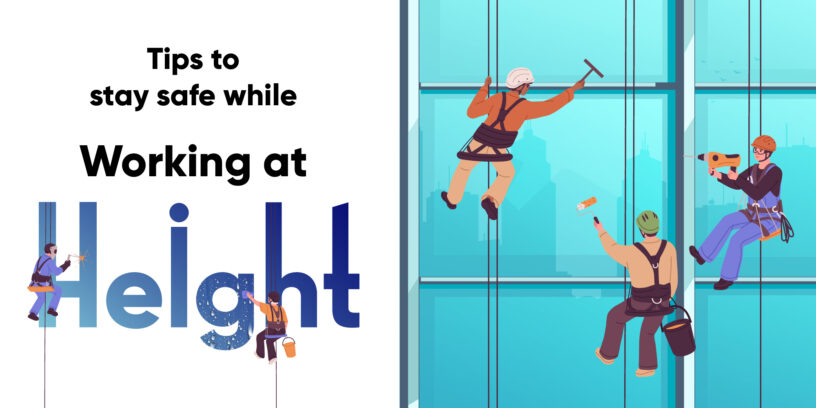Working at a height can be extremely risky, especially during an emergency rescue mission. Accidents and injuries happen whether you are working high up on a construction site or in the middle of a disaster relief mission which is why it is critical for workers to be prepared for whatever dangers may arise. This blog post will walk you through guideline that will enable you to stay safe while you work at height.
1. Wear Protective gear & appropriate clothing
Use the correct safety equipment before doing any job at a height. These could include hard hats, safety glasses, harnesses, lanyards, fall protection equipment, and steel-toed boots.
2. Know your Surroundings
Be sure you understand your surroundings and the tools you’re using. Examine the scaffolding for risks such as electricity lines, uneven ground, or gaps that could cause a fall.
3. Falling Objects
Whenever there is a chance of a head injury from falling or being struck by objects, use a hard hat (for example, flown scenery, tools, lighting equipment, or tail ends of the cable).
4. Examine your safety gear
Check any safety equipment for wear or damage before utilising it at a height. To protect your safety, make sure all components are fastened and set up correctly.
5. Follow the procedures
Make sure you strictly adhere to any established protocols for working at heights if there are any. This can entail performing pre-work inspections of the scaffolding or safety harnesses or performing tasks in a particular order.
6. Unstable or Slippery Surfaces
The footwear that technicians or workers must wear offers protection from current dangers. Let’s say that a worker cannot wear the typical protective footwear. In that situation, the employer is required to take further precautions to safeguard the employees from harm, such as fitting costume shoes with nonslip bottoms, altering the floor surface, or eliminating the danger.
7. Escape Plan
Prepare an escape strategy in case you find yourself in a risky position. Be aware of the best way to exit the height and be ready to use it if necessary.
8. Stay focused
Distractions and daydreaming are not appropriate while working at a height! To keep safe and prevent accidents, pay attention to what you are doing at all times.
9. Ask for help
Everyone isn’t expected to be an expert in safety, so don’t be afraid to ask questions or get help if you’re confused. Instead of rushing through and running the chance of an accident, it is best to take your time and do it well.
10. Take breaks
Take frequent breaks when working at heights because it can be both physically and emotionally draining. Your energy levels will be maintained and the likelihood of mishaps caused by exhaustion will be decreased.
11. Report Incidents
Report any incidents involving accidents at height to the appropriate authorities and make sure they are properly documented. This will safeguard people from damage and aid in the prevention of future mishaps.
12. Weather-check
It’s crucial to pay attention to the weather both before and during performing high-level job. Make sure to take extra measures when working in these conditions because strong winds, thunderstorms, rain, and other extreme weather conditions might raise the danger of an accident.
13. Know your limits
Being at a height can be frightening and physically taxing, so be mindful of your limitations at all times. Don’t push yourself too hard or try to achieve something you’re not comfortable with.
14. Training
Before starting any job if you’ve never worked at a height, receive the necessary training. This will make sure that you understand how to handle any equipment safely and take the essential safety precautions.
15. High voltage
When operating close to activated high-voltage electrical equipment, respect the permitted range of approach. High voltage is defined as “a potential difference (voltage) of more than 750 volts between conductors or between a conductor and ground” in the regulation.
16. Fall protection
When working at a height, you should always wear the proper fall protection. Safety harnesses, anchor points, guardrails, and other tools intended to stop falls and safeguard you in the event of an accident may come under this category.
17. The three points of contact rule
When climbing ladders or other structures, remember the three points of contact rule. In order to retain your balance and avoid falls or slips, you must keep at least two hands and one foot or two feet and one hand on the framework.
18. The right tools
Your safety can be significantly improved by using the proper tools. To guarantee that you can accomplish the operation securely, make sure you have the appropriate ladder, scaffolding, harnesses, and other equipment.
Conclusion
You may make sure that you stay safe while working at heights by adhering to these instructions and adopting the essential safety precautions. Always be aware of your surroundings, wear the appropriate safety gear, and avoid attempting anything that makes you uncomfortable. You can guarantee that your work is completed safely and effectively if you have the necessary information and preparation.
Take the required actions to maintain a safe working environment since your first priority should be your safety and the safety of others around you. You may make sure that everyone stays safe while working at height by adhering to the tips given above.














Leave a Reply